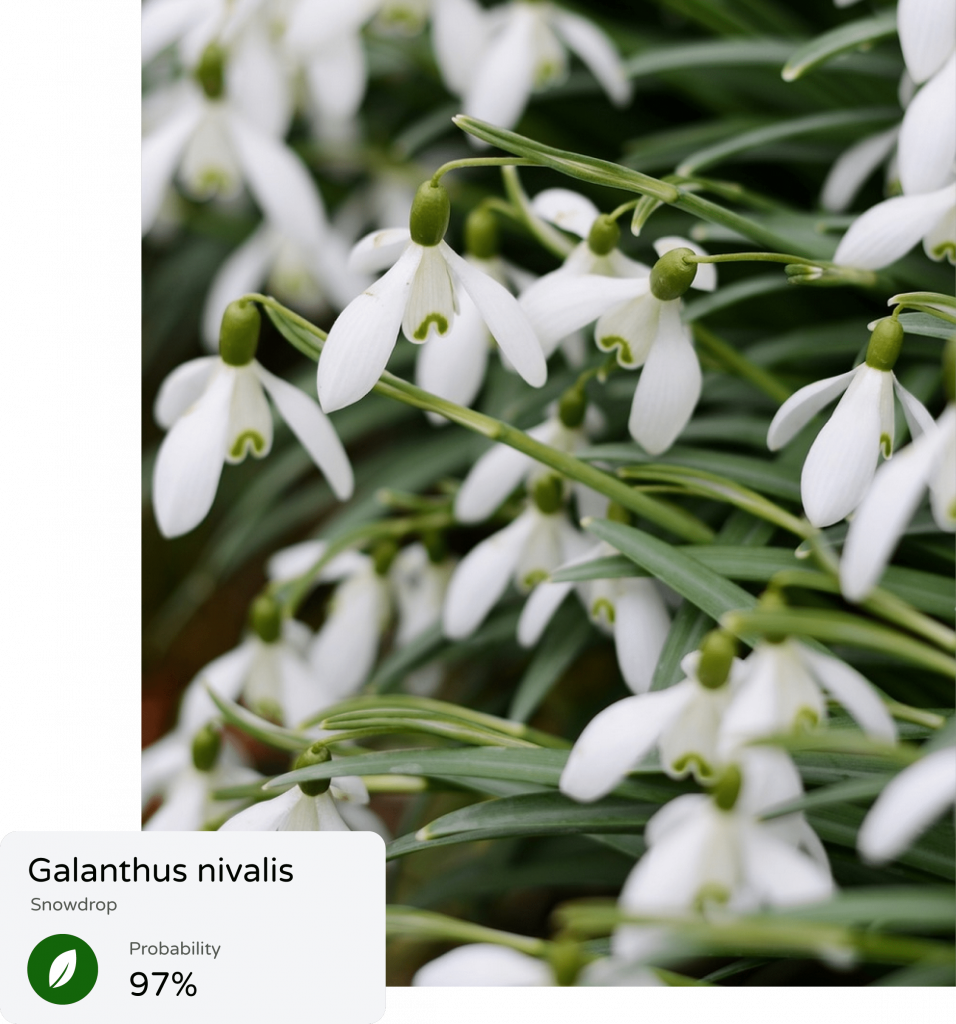Plant.id API is machine learning plant identification service
The API uses machine learning to identify plant species from photos. Send us images of your plant and receive possible suggestions with associated information, including representative images of the species.
- Unlimited scalability
- Easy integration
- Extensive documentation
- Complex plant info
- Adaptive representative images

Model specification
35 000+
Houseplants, wild plants and garden ornamentals. Trees, shrubs, herbs and grasses. All living things that grow on land or in water.
93%
The TOP3 accuracy. It is the probability that the correct plant is listed in the first 3 suggestions.
The TOP1 accuracy is 86% and the TOP10 accuracy is 97%.
Read more on our blog.
Features

Similar images
Get adaptive representative photos of suggested plant species. Photos are dynamically selected from our database to resemble the submitted photo. We provide you with a license to use these images in your application. Read more.

Plant information
You will get additional information about suggested species, like taxonomy, description, common (vernacular) names in different languages, edibility, propagation methods, Wikipedia link, and more. See the documentation for more details.

Plant disease identification API
Having problems with spider mites, powdery mildew or simply overwatering? In addition to species, Plant.id can identify almost 100 diseases. Use one of the health assessment modifiers in the request to get information about the health of your plant. See more details about the Health Assessment feature.
All the identification data packed into JSON
Send us photos of the plant in a POST REST API request and you will get multiple species suggestions in the JSON formatted response. In addition to the Latin (scientific) name, you can also get additional plant details:
- synonyms
- common (vernacular) names
- taxonomy
- plant description
- edibility
- propagation methods
- watering recommendations
- representative photos
- URL with detailed information
- Wikipedia images
- GBIF species id
Check the sample codes on Postman in different programming languages.
{
"access_token": "GIe6akEJKXSBebJ",
"model_version": "plant_id:3.1.0",
"custom_id": null,
"input": {
"latitude": 49.207,
"longitude": 16.608,
"similar_images": true,
"images": [
"http://plant.id/media/imgs/44681b0e7ed14fa7b086c53f6daec144.jpg"
],
"datetime": "2023-07-10T06:37:48.133286+00:00"
},
"result": {
"is_plant": {
"probability": 0.47637302,
"binary": false,
"threshold": 0.5
},
"classification": {
"suggestions": [
{
"id": "ae8faed4a61d9de2",
"name": "Leucojum vernum",
"probability": 0.9998723,
"similar_images": [
{
"id": "587aeca4494253948c702d8356b4bebc2557a63d",
"url": "https://plant-id.ams3.cdn.digitaloceanspaces.com/similar_images/3/587/aeca4494253948c702d8356b4bebc2557a63d.jpg",
"license_name": "CC0",
"license_url": "https://creativecommons.org/publicdomain/zero/1.0/",
"citation": "hen_ry",
"similarity": 0.683,
"url_small": "https://plant-id.ams3.cdn.digitaloceanspaces.com/similar_images/3/587/aeca4494253948c702d8356b4bebc2557a63d.small.jpg"
},
{
"id": "dffa4fc0912feefa1516df8c20c080286556269f",
"url": "https://plant-id.ams3.cdn.digitaloceanspaces.com/similar_images/3/dff/a4fc0912feefa1516df8c20c080286556269f.jpeg",
"similarity": 0.543,
"url_small": "https://plant-id.ams3.cdn.digitaloceanspaces.com/similar_images/3/dff/a4fc0912feefa1516df8c20c080286556269f.small.jpeg"
}
],
"details": {
"language": "en",
"entity_id": "ae8faed4a61d9de2"
}
}
]
}
},
"status": "COMPLETED",
"sla_compliant_client": true,
"sla_compliant_system": true,
"created": 1688971068.133286,
"completed": 1688971068.496495
}Technology
To get the best results of our plant identification API, our tech stack uses PyTorch and a python-based heavy lifting. We also use Digital Ocean platform and Amazon Web Services.
The neural network’s architecture is based on the Inception model, but we have implemented a bunch of customization, for example, to estimate identification certainty, select the best adaptive representative photos and improve the accuracy with meta attributes, such as GPS coordinates.



Plant.id is the best solution for plant identification
According to an article from professor Hamlyn G. Jones: What plant is that? Tests of automated image recognition apps for plant identification on plants from the British flora, AoB PLANTS, Volume 12, Issue 6, December 2020.
We owe much of our success to our botanists, who have identified hundreds of thousands of photos for the FlowerChecker app since 2013.

Pricing & Payment
The cost of each identification call is 1 credit. The cost of obtaining plant information from the Plant Detail endpoint using the Plant Search feature is 0.5 credits.
The base price of 1 credit is €0.05. Significant discounts are available for higher volumes of identifications. Please tell us what you need at business@plant.id.
You can choose a prepaid or retroactive model. The preferred payment options are card and wire transfer. Alternatively, you can use PayPal.
See our FAQ section for more details.
